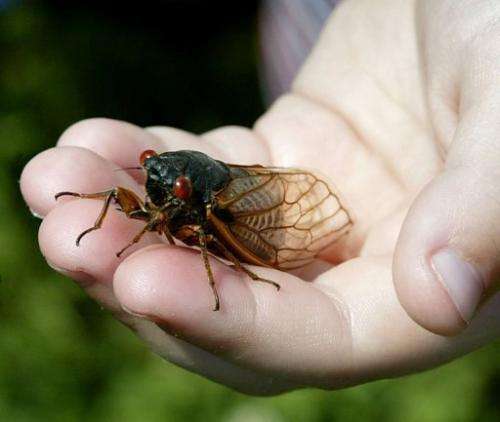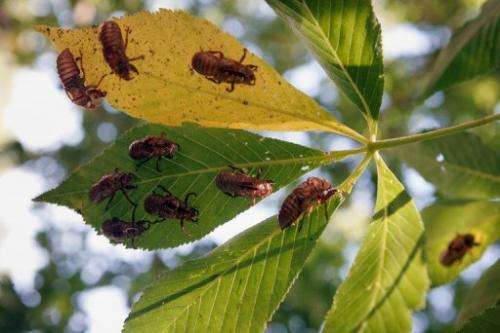The cicadas are rising: US invasion in 5, 4, 3...

The hordes are rising. A cicada invasion is imminent in the US, with millions of the large cricket-like insects poised to emerge from the earth after 17 years lying in wait. The first of the bugs that are expected to blanket the US east coast have already been spotted in North Carolina and New Jersey.
"The Brood II emergence has begun!" cheered the site cicadamania.org on Monday, where the subculture of insect fans can record sightings.
But the onslaught will truly begin later this month, once the average ground temperature hits 64 degrees Fahrenheit (17 degrees Celsius).
At its peak, there could be swarms with between one and two thousand chirping critters per square yard (meter).
Although cicadas are common around the world, this cyclical phenomenon happens only in the United States.
Every 17 years, these "periodical cicadas" mature, mate, lay eggs and die in a deafening concerto.
Their offspring—which won't be seen again for another 17 years—burrow into the ground, eight inches (20 centimeters) deep, where they will feed on the sap from roots until their day in the sun arrives.
The broods—there are 15 of them—are classified by Roman numeral.
Most are on a 17-year cycle, though three reproduce every 13 years and the cycles are staggered, meaning that at least one of the broods hatches each year.
But not all broods are created equal and "Brood II" is a big one.
Over the next few weeks, they will emerge and launch a reproductive orgy when the larvae split their skins and mature into adult form, explained University of Maryland entomologist Michael Raupp.
"Then they'll scramble in a flight to the treetops. The males will begin to court the females. They will mate," he added.
The females will "lay their eggs, these eggs will hatch and will tumble down to the earth, and feed again for another 17 years."
The bugs, of the scientific order Hemiptera, are about an inch long (two to three centimeters).

They're black and have red eyes and translucent wings with orange veins. They don't sting and only threaten the young trees they will pump for sap.
And they will be loud. The males sing to the females in a mating call created through their tymbal, an abdominal membrane. By the thousands, the unique chirp rises to a deafening roar.
Most of the cicadas will die quickly, preyed on by birds and small mammals, including mice and even dogs.
"Adult cicadas are a huge source of food for various animals," said Andrew Liebhold, Agriculture Department entomologist.
"They are a very good source of nutrition and enhance reproduction of several species of birds and mammals."
But Raupp noted that bigger mammals—say, homo sapiens—have also been known to take a taste.
"They are higher in protein and lower in fat than a steak," Raupp said, adding he prefers them raw.
For those who might be wary of eating bugs, Biologist Jenna Jadin, who wrote a short manual on the subject as a student at the University of Maryland, suggests they be treated just like fellow arthropods, crab or lobster.
After boiling them for four or five minutes, she suggests "Maryland cicadas" with onions, potatoes and corn; "Shanghai cicadas" with soy sauce, garlic and turnips; or perhaps "pizza a la cicada," with basil, olives and onions.
© 2013 AFP



















